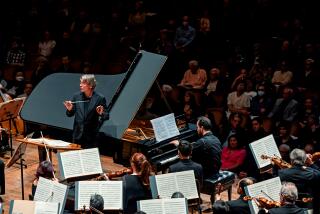Tenney’s visions brought to life
- Share via
Composer James Tenney has claimed that he tries to avoid emotionality in his music, preferring to explore diverse experimental ideas. Yet on the evidence of the career-spanning “James Tenney at 70” concert Thursday night at REDCAT, dodging emotion is one goal he hasn’t entirely attained. A certain austerity hovers over his work, but the results are never served cold.
Currently the music department chair at CalArts, Tenney has long been involved in avoiding the usual. He has delved into conceptual Minimalist ideas, mathematical procedures, just intonation, drones and chance operations, with affectionate nods to his hero and colleague John Cage. He has also pursued interests in acoustical and perceptual phenomena: how we listen as much as what we listen to.
What might sound dryly intellectual on paper, however, came alive Thursday as the workings of a fine, elastic musical mind.
In a compact this-is-your-life fashion, the program -- featuring the Montreal-based Bozzini Quartet, who are Tenney specialists -- leapt back and forth in time and styles. It even included the world premiere of a 1955 string quartet, written when Tenney was an obviously gifted, and obviously Bartok-copping, 21-year-old student. The solo “Just a Bagatelle,” played lucidly by violist Stephanie Bozzini, was a rare trip into serialist writing, and the composer’s unexpected, astringent grace was intact here as well, showing a love of timbre and punctuating silences.
Indeed, the careful-yet-freedom-loving Tenney touch governed the entire program, which was neatly framed by two versions of his piece “Koan.” The first, written in 1971 and played with illuminating care by Clemens Merkel on violin, is simple in design, haunting as a listening experience. Two tones steadily oscillate, one constantly shifting in near-infinitesimal pitch variations, creating an aural tension and the sense of a magnetic field in flux. Closing the concert was a string quartet version written in 1984, with the sonic and strategic plots thickened.
“Koan” is one of Tenney’s “Postal Pieces,” its musical designs rudimentary enough to fit on a postcard. Another was “Having Never Written a Note for Percussion,” in which Danny Holt created a real-time arc of crescendo and decrescendo on the tam-tam.
“Ergodos II (for John Cage),” from 1964, represented Tenney’s electronic music phase, when he worked at Bell Labs with engineer Max Matthews. It remains an effective example of electro-acoustic music, featuring a quintet of live musicians engaging in delicate transitory dialogue with phantom electronics. In the string trio piece “Harmonium #5,” glimpses of logic and order keep abutting anarchic disjointedness. Harmonies happen, then disperse in a semi-random universe.
Whether or not Tenney intends it, his music is engagingly meditative on more than one level, alluring in sound and thought.
More to Read
The biggest entertainment stories
Get our big stories about Hollywood, film, television, music, arts, culture and more right in your inbox as soon as they publish.
You may occasionally receive promotional content from the Los Angeles Times.










